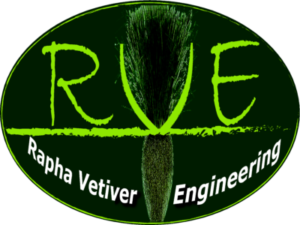The Vetiver System is based on the use of vetiver grass (Vetiveria zizanioides L.) for various applications in erosion and sediment control. The Vetiver System was first developed by the World Bank for soil and water conservation in India in the 1980s. (Truong 2002). It is non-invasive (-8 on the scale of invasiveness) due to its infertility and absence of rhizomes. It was identified as a useful grass for soil and water conservation (SWC) in the 1930s. When planted in dense hedgerows, it forms the basis for a long lasting, highly effective permeable barrier for SWC; as a bio-engineering tool for infrastructure protection; and a land restoration tool in integrated water resource management activities.
When it comes to infrastructure protection, the Vetiver System has been applied to cut and fill slopes on highways and railroads throughout the tropics and semi-arid parts of the world, as well as on culverts, bridge approaches, drainage, and river banks, and has been proven to function well over the long term. Not only does the Vetiver System guarantee near 100% success in slope stability, but it also reduces subsequent maintenance costs as it prevents silting of drains and provides protection against culvert and bridge wash outs.
Applications of the Vetiver System
The following are the 5 common uses of Vetvier Grass.
- On-farm: Soil & water conservation (SWC) on slopes and in plains; and gully plugging. Added benefits: fodder, handicraft (roof thatch, baskets, hats), pest control (on-farm and storage). In all applications for soil stabilization, the basic principle is the dense thick hedgerow that helps water flow reduction, dissipation, and infiltration. Slow! Spread! Sink!
- Water-related infrastructure: Embankment stabilization on Dams/Pans, banks of rivers, canals, dikes, levees, and shores – also erosion control and trapping silt, and improving ground water recharge.
- Rehabilitation of vegetation: Assisting reforestation, afforestation, rehabilitating contaminated soils, gully rehab, fixing dunes affected by water/streams or wind.
- Infrastructure: Slope stabilization, landslide prevention on roadsides, railways, bridges, silt/sediment control in culverts and drains, dealing with point-source erosion caused by improper drainage, etc.
- Waste water treatment: Sewage /black water, industrial pollution, waste dump leachate, mine rehabilitation – taking in the roots most toxins and contaminants.
- Potential for fodder: Vetiver stem and leaves make excellent fodder with high nutritive value if cut and fed when young. The protein content in a fresh Vetiver stem and leaf is higher than that in alfalfa, Symphytum officinale, clover, sweet potato, vine, and rice straw and a little lower than that of milk vetch. Vetiver hay has lower protein content than that of alfalfa but higher than that of maize silage and common winter livestock fodders such as rice and highland barley straws. Moreover, the methionine content of Vetiver is almost the same as in other fodder crops, while the lysine content was much higher. Thus fresh Vetiver as fodder is beneficial for livestock growth and provides a quality feed for wild animals and livestock especially for cattle and sheep because of good palatability and data shows that farmers in china are producing and feeding 140 tons/ha/year of fresh Vetiver or 46 kg/day/ha to livestock.
- Other applications: In addition, Vetiver grass has other community-oriented uses including; forage, bio-fuel, thatch, handicrafts, medicinal purposes, as a mattress filler, for (storage) pest control, mulching, and making of briquettes etc.
